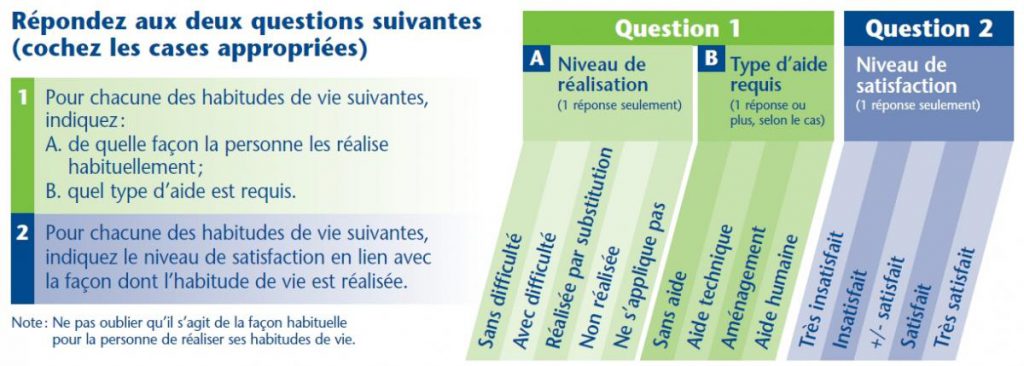Use of LIFE-H
By using the LIFE-H questionnaire, it is possible to establish a social participation profile. All statements must be answered in order to establish a social participation profile. Such a profile makes it possible to identify the life habits perceived as being the most disturbed and those being carried out with the least satisfaction. This makes it easier to take into account the preferences and needs of people with disabilities and their families.
In addition, the information collected using the LIFE-H can support carrying out individualized intervention plans, program evaluation initiatives, service development, research activities, etc.
If two or more questionnaires were produced at different times, it is possible to compare the results obtained. Observed differences tell you of changes in personal factors or environmental factors.
The level of satisfaction of the respondent’s social participation is measured on a five-point Likert scale. The answer choices range from “very dissatisfied” to “very satisfied”. The level of quality of the social participation is obtained from the grouped answers on the “level of achievement” of the life habits and the “types of help required” to realize them.
LIFE-H data may be useful in areas as diverse as adaptation, rehabilitation, social participation and the exercise of human rights.
Measuring scale
The format of LIFE-H questionnaire includes three questions that will need to be asked for all of the life habits included in the chosen version of the assessment tool.
Measure the quality of social participation:
The level of quality of social participation is obtained from the responses collected on the “level of achievement” of the life habits and the “types of help required” to achieve them.
Measure the level of satisfaction:
The level of satisfaction is measured on a five-point Likert scale. The choices for answering this question range from “very dissatisfied” to “very satisfied”.
LIFE-H Applications
The Assessment of life habits (LIFE-H) can be useful in various areas such as adaptation, rehabilitation, social participation and the exercise of human rights.
Individual Level
Individualized Intervention Plans
Using LIFE-H allows to identify life habits that are perceived as being the most disrupted or less satisfying. In this way, LIFE-H is a tool that can be used to develop individualized intervention plans based on the person’s life plan. The LIFE-H also helps determine whether a new individualized intervention plan must be made following changes to the person’s life habits.
Collective Level
Program Evaluation
Compiling LIFE-H data on the achievement of life habits or level of satisfaction enables us to have a more global understanding of client’s social participation profiles. This information can be used to guide and change the program service offering based on the life habit categories that are the most difficult or less satisfying to carry out.
The LIFE-H can be used as an indicator of effectiveness of an ongoing program evaluation process. These objective data facilitate decision-making with regard to improving the services given under a program. They promote accountability.
Scientific Research
Data collected on the level of accomplishment of life habits are used to produce a social participation profile for different clients. The LIFE-H supports the evaluation of the effectiveness of interventions, identifying whether they impact the achievement of life habits. It also allows to follow up on developments in accomplishing life habits and to follow up on what has been learned.
Population Level
Policy Development
The creation and monitoring of social participation population profiles tells decision makers whether the programs in place promote or hinder the social participation of people. The LIFE-H also supports the adaptation of policies that promote the social participation of clients whose life habits are the most disrupted.
Population Surveys
The LIFE-H provides general but complete information regarding social participation in the population. It is used to evaluate changes arising in achieving life habits over a given period of time.
